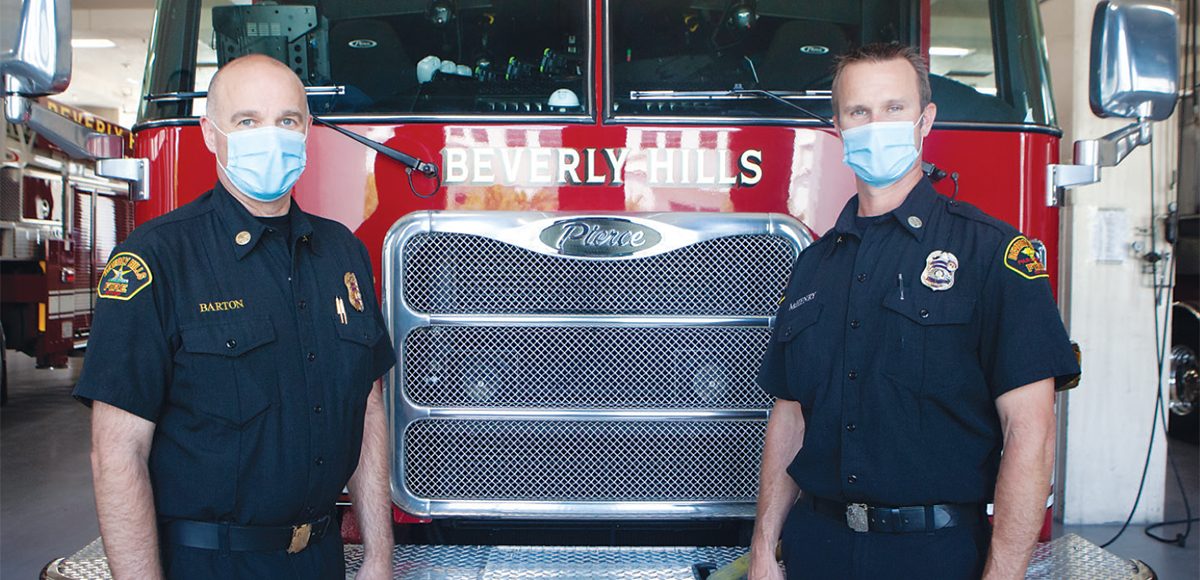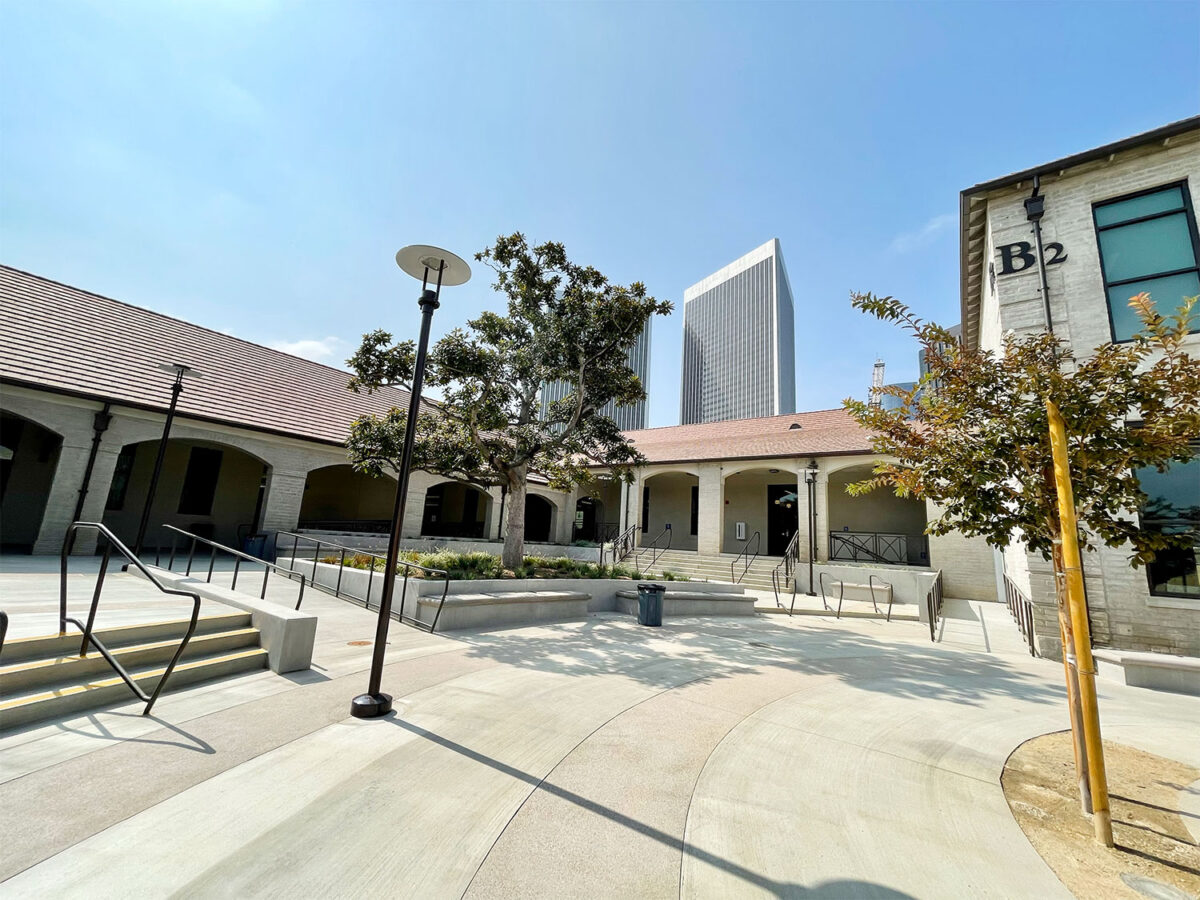The first hint of real trouble for the Beverly Hills Fire Department came in February, when one of the firefighters shared that their child’s school had been canceled due to COVID-19. The next day, Battalion Chief Scott Stevens received the same news about his child’s school. “Then the next morning, it was my [child’s] school,” recalled Captain Brad McHenry.
As essential workers, firefighters didn’t have the option of returning home to help spouses cope with the extra workload. Instead, the members of the 95-year-old department had to reconfigure routines, implement new protocols, and adjust to a strange new world of firefighting in the era of COVID-19.
The Courier obtained inside access to the day-to-day workings of the Beverly Hills Fire Department, as it continues to cope with life during the pandemic.
Call Load Changes
After the stay-at-home order went out, “our call load went down as well, because you weren’t getting as many traffic accidents [and] fire alarms weren’t going off,” Beverly Hills Fire Chief Greg Barton told the Courier during a visit to the station June 23. In fact, calls went down by around 30 percent. “But now we’re starting to see that go back up because people are coming back to work and traffic is increasing,” he added.
The majority of the calls that the fire department receives are medical related, not fire. About half of the crew are trained paramedics. The coronavirus has necessitated a slightly more cautious approach in responding to emergency calls, although Stevens stressed that they are no slower for it.
“It’s a little more measured,” he said. “We have one member who dresses up in a complete disposable gown, gloves, an N95 mask, and goggles.” That member approaches the patient on their own to assess the situation, the level of care needed, and whether the patient exhibits possible COVID-19 symptoms. The other five first responders hang back and fulfill other roles unless they are needed by the patient. Dispatchers in the 911 system also go through a preliminary screening with all callers for possible virus symptoms.
Safety protocols include running an autoclave system in the rescue vehicles to decontaminate them. The department caught a break in terms of timing – they had already started implementing enhanced sanitary procedures a year before the pandemic and had built up stores of cleaning products.
The department counts itself as lucky for never running out of PPE, even when supply lines around the world ran dry. “We’ve been fortunate that we’ve always had what we need,” Stevens said. Nonetheless, Barton has had to get creative at times in sourcing supplies.
Station Life Adjustments
Life inside the station has changed on a day-to-day level. Firefighters do more than just work at the station – they also live there. About a third to half of their typically 30-year career is spent at the station, sleeping, eating, training, and waiting on calls. The highest risk of COVID-19 transmission occurs between household members and a fire station is essentially one large household, with at least 15 members living there at all times.
Whenever anyone arrives at the station, they have their temperature checked. Over 100 degrees, go home; under 100, you can stay. Everyone in the station wears a mask, only removing it for meals, showers, sleep, and working out. Stevens said that the department members don’t get tested for the virus unless they show possible symptoms.
The balcony on the station’s second floor living quarters looks out over the City – not the worst view if you plan to spend 30 years there. Every entrance to the second floor has a special mat saturated with cleaning fluid to remove any contaminants on the bottom of shoes.
Before the pandemic, many of the firefighters were accustomed to sleeping two to a room. But, starting sometime in February, the department reconfigured the rooms to sleep only one (except for the newly repurposed screening room, which is large enough to sleep two people at either end).
Mealtime is different now, as well. The 15 firefighters on duty used to sit together at the two large tables that make up the dining room. Not quite shoulder-to-shoulder, but certainly not six feet apart. Now, the mess area is crammed with two additional folding tables, and the space normally occupied by a foosball table and ping pong table is filled with Lay-Z-Boys from the repurposed screening room.
Working out together has also taken a backseat to health concerns. These days, if one person pumps iron in the weight room, anyone else looking to do the same has to take the weights outside to the patio.
As for leisure time, “The days of sitting down and watching TV are over,” said Firefighter Melissa Hillis, as she prepared lunch in the station’s industrial kitchen. “We have so many jobs with the added job of sterilizing for COVID – everyone has to chip in.” She gestures to the kitchen window looking outside onto the patio: “As you can see, the Battalion Chief of the entire station is now cleaning tables like a bus boy.”
Training for the Future
Training procedures have had to change as well. With the new Metro Purple Line extension coming through the City, the team has been practicing tunnel rescues. About eight members of the department are training in the use and upkeep of rebreathers. “We used to bring everybody here [and] have one big class. We’ve got to figure out how to do it with Zoom,” said Barton.
One eventuality the department would rather not contemplate is the all-hands on deck scenario of an epic blaze in the state. California fire departments regularly assist each other in battling those fires, such as the Camp, Mendocino Complex, and Thomas fires of the past few years.
“This new norm that we have, fire season is year-round. In the past, it was usually May to November,” said Barton.
In the unfortunate event that a fire erupts requiring a multi-departmental response, logistics will look considerably different than before.
Pre-pandemic, firefighters would congregate in “fire camps” with anywhere between a few hundred to a few thousand other fighters. The camps were an epidemiological nightmare: large meetings attended by all of the captains and strike leaders, buffet-style eating, sleeping trailers with three-tiered bunk beds. Now, the meetings will be held remotely, and each meal will be individually sealed and delivered to the engine company directly.
As cool breezes swept across Beverly Hills this week, the fire camp scenario seemed a remote possibility, for now.







